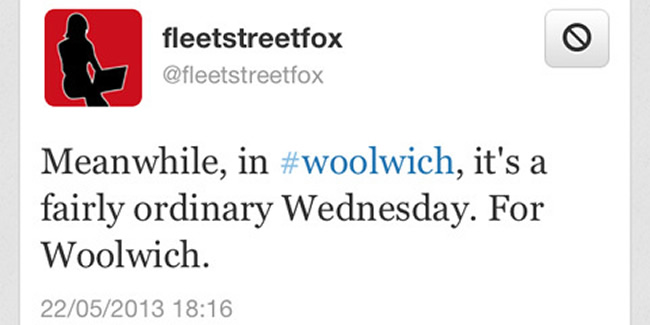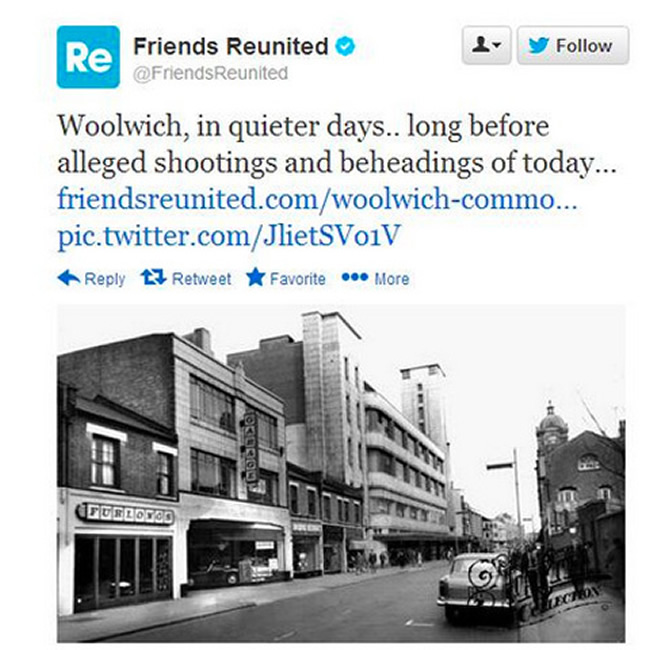Enlightened bigots say Lee Rigby is a victim of Woolwich and ‘Sarf’ London’s dragons
WHEN the barbaric, racist loons responded to the voices in their heads by murdering Lee Rigby in Woolwich, London, the chattering classes went to work analysing them and us. But the Mirror’s Fleet Street Fox managed to to carve out her own reasons why two men should hack a stranger to death in the street:
It’s all bit like when FFFox’s Mirror newspapers’ colleague Brian Reade visited Eltham, south London, in the wake of Stephen Lawrence’s murder by racists:
Welcome to the Brook Estate in Eltham, south east London. The breeding ground of four of the five men accused of stabbing Stephen Lawrence to death as he waited for a bus a short walk away on the eve of St George’s Day six years ago.
Five products of a twisted philosophy drummed into them from birth. “If they’re black, stab ‘em in the back.”…
A way of life passed down from father to son. You see the link emerge in the fading white graffiti sprayed 30 years ago on the walls of the old railway bridges around the estate, written by the last generation of Eltham Boyz. In three feet high letters: “SKINHEADS.”…
Give me the father and I’ll give you the son who will give you the son who will abuse, persecute and even kill another human being for committing the heinous crime of not being born white.
Racism was inherited. Get the killers and purge the land.
This is White Man’s Gulch… This is E-reg Escort-land.
What is it with Mirror journalists banging on about an area they know nothing about?
GK Chesterton and Michael Collins put it well:
“We are always ready to make a saint or prophet of the educated man who goes into cottages to give a little kindly advice to the uneducated,’ he wrote. But the real saints and prophets – those of the middle ages – were uneducated men ‘who walked into grand houses to give a little kindly advice to the educated.’ The wisdom of the poor was once deployed to moralise the rich; now that of the rich is used to demoralise the poor.”
Ken Welsby actually lives in the Heart of Darkness. He writes about life where the dragons roam:
Friends, neighbours and the local community. That’s a word we hear a lot. But what does it mean? In the last 36 hours Woolwich has given a new meaning to the word.
Ours is a town in transition. This used to be a bustling, working town that rubbed sholders at times uneasily with its neighbours in the borough: tourist, arty Greenwich up river and leafy residential Eltham to the south.
But over 30 years we have lost the four main generators of employment which provided, if not exactly prosperity, then at least a decent living and, more importantly, a sense of place.
The decline and closure of the Royal Arsenal was a long-drawn out affair which took out the largest source of male, manual work.
The poly – originally conceived to provide the arsenal’s technical skills and training – transmogrified into the uni, and then moved up and down river: arts and humanities to Greenwich, engineering and science to the Medway.
Morgan-Grampian publishing, where bright young folk learned the hard lessons of business publishing – both journalism and sales – declined and broke up.
By then the Artillery had long gone to Salisbury plain, and the Barracks was no longer packed with squaddies spending their money – and meeting the girls – in the local pubs.
In recent years there has been a revival. New flats on the riverside – the new square, more social housing, the new civic centre and now the amazing new Tesco development – a supermarket too big for me to explore topped with blocks of futuristic flats. And the Barracks has a new lease of life. But we are still short of core employment, and the town centre regeneration is still a work in progress.
But on Wednesday afternoon the people of Woolwich showed the world that we are a community. The brave women who faced Lee Rigby’s killers – who “thought they’d better keep them talking so they didn’t attack anyone else” and knelt by his side in a silent vigil of thoughts and prayers. The teachers who shielded their children from the horror yards from the school gate. All those who stood on the street, refusing to hide indoors, or took flowers to the crime scene or the barracks gate. And the mosque, who were quick to condemn the crime as evil.
Woolwich – I’m proud to live here.
That was spotted by spotted by Daryl at 853 Blog, who also saw another fool damning Woolwich:
As our Mof says:
Friends Reunited there, with a bizarre idea of trying to capitalise on something that was trending on the social network.
And our Ed, a south Londoner, sums up:
South-East London has never enjoyed a good press. Guidebooks treat it as an afterthought, an appendix to the real business elsewhere in the capital. Historical Greenwich is mentioned, of course, and a handful of other tourist-friendly sights, but that’s your lot. The days when the South Bank theatres were surrounded by syphilitic brothels and murderous backstreets are long gone, yet the stigma persists. This corner of the capital remains a world apart.
In modern times, this imaginative distance was reinforced by the way the area was cut off, not just by the Thames, but also from the Tube system. Public transport long consisted of unreliable trains and buses, and even taxis were famously reluctant to venture ‘south of the river’. The prevailing attitude among other Londoners was ‘ignore it, it might go away’.
But there was a corollary: if South-East London hadn’t existed, then someone would have had to invent it as a symbol of everything the cosmopolitan metropolis across the river was not. And in a way, that is exactly what did happen. Over the years, a caricature of this hinterland emerged, summed up in the phrase ‘Sarf London’ – a phonetic stab that fittingly bears no resemblance to the local pronunciation. The bottom right-hand corner of the London map became the modern equivalent of ‘here be dragons’.
This negative image was periodically confirmed on the rare occasions that the area hit the headlines: Teds and cosh boys in the fifties; the Richardson gang and the dockers’ march for Enoch in the sixties; the Lewisham riot and the Panorama programme on Millwall hooligans in the seventies; and so on. Even a good-news story like the Millennium Dome ended up as a PR disaster.
Such are the facts…
Posted: 26th, May 2013 | In: Reviews Comment | TrackBack | Permalink




